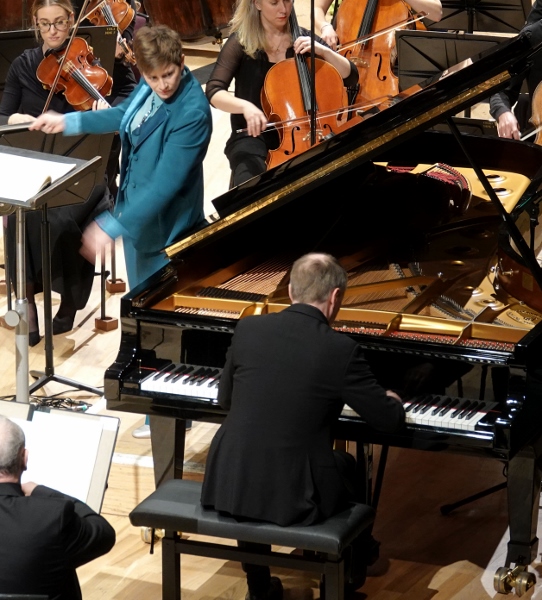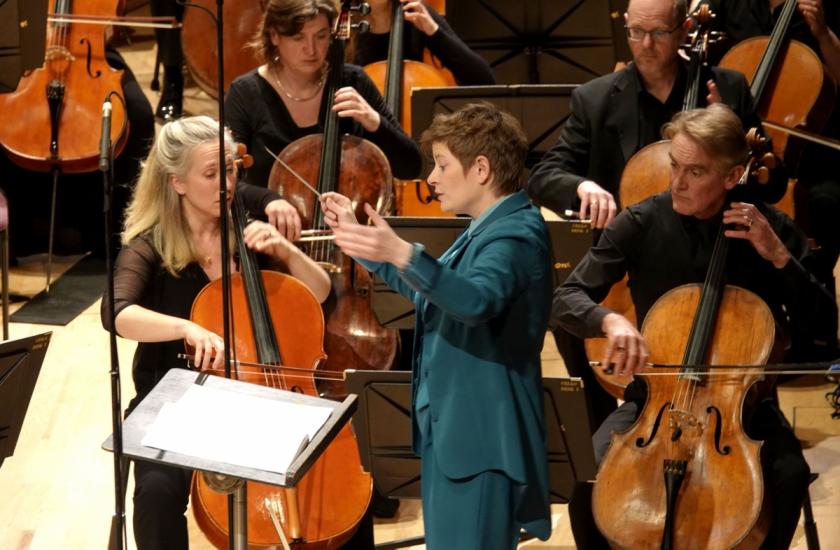Just a few days after the Hallé’s Bruckner 8, the BBC Philharmonic weighed in with his Seventh Symphony for its Manchester audience. We’re all getting a lot of Bruckner in his 200th anniversary year, and this was a wise choice, being one of his shorter creations in the genre – only about an hour and 10 minutes in playing time – and containing some of his best melodic ideas and rhythmic inventions.
It also benefits from the tonal qualities of an orchestra at the top of its game to realise the richness of the textures he created, and this was amply fulfilled in the sound of the Philharmonic, with Yuri Torchinsky in the leader’s chair.
Bruckner brought a chorus of four “Wagner tubas” to the mix in this symphony (as he did again for the Eighth), using them particularly in his Adagio movement with the bass tuba beneath. Conductor Anja Bihlmaier had the bass tuba up sticks from his familiar spot alongside the trombones and join them (and the horns) for that movement, then move back again for the remainder of the work: those listening on Radio 3 in two months’ time with good stereo may be able to track his spatial transitioning.
Her interpretation was a compelling one. Bruckner asked for “very slow” in the Adagio and “not fast”, followed by several calls for “broad”, “slowing” and “slow” in the finale (the atmosphere of cathedral worship, in which he often took part as organist, perhaps a part of his aspiration), but in practice it helped to keep things moving. Her approach made structures clear – the opening movement, after a slightly diffident beginning, soon picked up its stride and the second main theme was warm and rich, with the third one simultaneously insistent and thoughtful.
The Adagio flowed beautifully, its second theme poised and graceful. New soundscapes were revealed in considerable glory, especially at the first unveiling of the full brass sound, at the climax of the movement, and in the dramatic unison horns’ entry shortly before the final epilogue.
The Scherzo third movement is the one real opportunity for high spirits in the symphony, and it had them in full measure – almost with vehemence. Phrases were eloquently shaped with a light but intelligent touch, and Bihlmaier knew how to let melody lead the way (at the close of the Trio, especially). The finale, very sensibly, was frequently energetic, with impetus recovered whenever those markings indicated it should be.
 The symphony was set alongside Beethoven: his Fifth Piano Concerto, with Steven Osborne the soloist (pictured left). No surprise that the orchestral strings body was smaller here than for Bruckner, but in reality the 41 of them (one more double bass than a straight even-numbers list might prescribe) were a pretty hefty bunch, and he seemed to like to match the muscular sound they made. He opened with the concerto’s surprise cadenza-style effusions in grand style (oddly, the third piano-and-tutti chord not quite in sync both at the outset and in its reprise), and then there was a graceful, swaying contrast, first from the orchestra at Bihlmaier’s behest and then from the piano, in the second main theme. Contrast and a wide range of power were the order of the day (more than would have been possible on pianos of Beethoven’s day, probably, but there’s a whole tradition of big-boned playing in Beethoven concertos), and very effectively so.
The symphony was set alongside Beethoven: his Fifth Piano Concerto, with Steven Osborne the soloist (pictured left). No surprise that the orchestral strings body was smaller here than for Bruckner, but in reality the 41 of them (one more double bass than a straight even-numbers list might prescribe) were a pretty hefty bunch, and he seemed to like to match the muscular sound they made. He opened with the concerto’s surprise cadenza-style effusions in grand style (oddly, the third piano-and-tutti chord not quite in sync both at the outset and in its reprise), and then there was a graceful, swaying contrast, first from the orchestra at Bihlmaier’s behest and then from the piano, in the second main theme. Contrast and a wide range of power were the order of the day (more than would have been possible on pianos of Beethoven’s day, probably, but there’s a whole tradition of big-boned playing in Beethoven concertos), and very effectively so.
In the slow movement the muted strings created a delicate cushion of sound, and the piano, beginning una corda, followed their example… before passion made itself felt. It was eloquent and a model of classic sensibility. The finale was rhythmically energised, its three-in-a-bar dancing along: soloist and conductor equally delighted with its effect, and so they were entitled to be.
Osborne added a gentle wisp of a miniature by way of encore, based on a theme by Keith Jarrett.
- To be broadcast on Radio 3 on 8 May
- More classical reviews on theartsdesk














Add comment